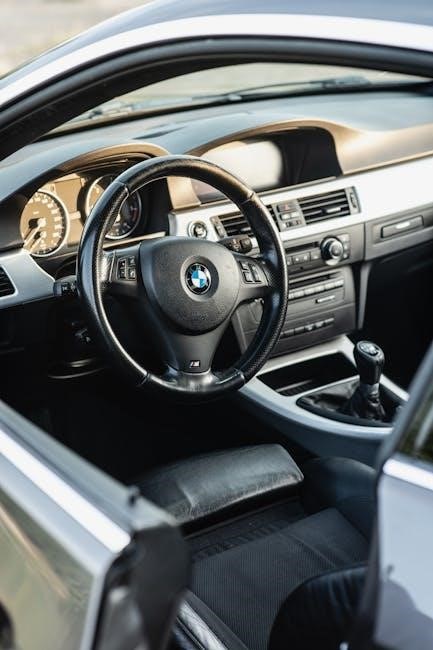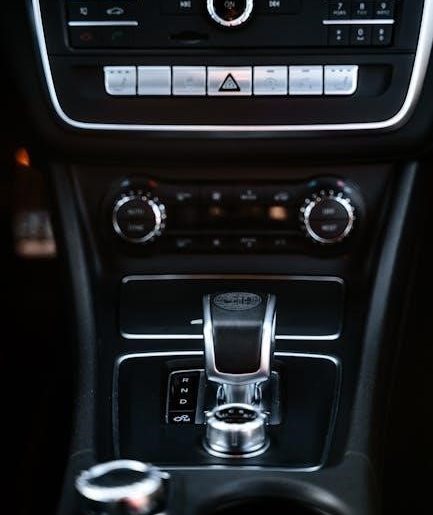The evolution of automotive technology has sparked debate over manual vs. automatic transmissions. Manual transmissions offer control, while automatics provide convenience. This article explores the process, benefits, and challenges of converting a car from manual to automatic, helping drivers make informed decisions.
1.1 Overview of Manual and Automatic Transmissions
Manual transmissions require drivers to operate a clutch pedal and gear stick to change gears, offering control and fuel efficiency. Automatic transmissions use a torque converter to shift gears automatically, providing convenience and ease of use. Both systems have distinct mechanisms, with manuals relying on driver input and automatics relying on hydraulic or electronic systems to manage gear changes seamlessly.
1.2 Importance of Transmission Type in Vehicle Performance
Transmission type significantly impacts vehicle performance, fuel efficiency, and driving experience. Manual transmissions often deliver better fuel economy and precise control, appealing to enthusiasts. Automatic transmissions prioritize convenience, especially in urban driving, and are ideal for those seeking ease of use. The choice between manual and automatic can influence acceleration, handling, and overall driver satisfaction, making it a critical factor in vehicle selection and modification decisions.
Can You Change a Car from Manual to Automatic?
Yes, converting a car from manual to automatic is feasible but complex, requiring significant mechanical expertise and financial investment to ensure compatibility and functionality.
2.1 Feasibility of Transmission Conversion
Converting a manual to automatic transmission is feasible but involves complex modifications. It requires swapping the manual gearbox with an automatic unit, ensuring compatibility with the engine and drivetrain. Modern vehicles may need additional components like sensors and software updates. While technically possible, the process demands significant expertise and resources, making professional assistance essential for a successful conversion.
2.2 Factors Affecting the Conversion Process
Several factors influence the transmission conversion process. The vehicle’s make, model, and year play a crucial role, as compatibility varies. Availability of automatic transmission parts and necessary software updates are key considerations. Additionally, the vehicle’s engine and drivetrain must support the automatic transmission. Labor costs and expertise of mechanics also impact the process, requiring specialized tools and knowledge. These factors collectively determine the complexity and feasibility of a successful conversion.
The Conversion Process
Converting a car from manual to automatic involves removing the manual transmission, installing an automatic one, and integrating necessary components like sensors and software.
3.1 Removing the Manual Transmission
Removing the manual transmission requires disconnecting the clutch, gearshift, and linkages. The transmission is then carefully lifted out, ensuring no damage to surrounding components. This step demands precision.
3.2 Installing the Automatic Transmission
Installing the automatic transmission involves mounting it securely, connecting the torque converter to the engine, and linking the transmission to the driveshaft. Proper alignment and connection of electrical and hydraulic systems are crucial. Compatibility with existing components, such as the engine and chassis, must be ensured. Additional modifications, like adjusting the crossmember or wiring, may be necessary to complete the installation successfully.
3.3 Integrating Necessary Components
Integrating necessary components involves connecting the automatic transmission to the vehicle’s systems. This includes installing a torque converter, transmission cooler, and adjusting electrical connections for sensors and solenoids. The ECU may need reprogramming to recognize the new transmission. Additionally, the driveshaft might require shortening to fit the automatic transmission; Proper integration ensures smooth operation, prevents damage, and maintains vehicle performance. While complex, correct integration is vital for reliability and optimal functionality.

Technical Considerations
Converting a manual to automatic involves compatibility challenges, requiring engineering expertise to adapt components like torque converters and ensure proper ECU integration. Specialized tools and knowledge are essential for a successful conversion.
4.1 Engineering Challenges
Engineering challenges in converting a manual to automatic transmission include adapting the drivetrain, ensuring compatibility of components, and integrating electronic controls. The process requires precise modifications to the vehicle’s structure, including the installation of a torque converter and adjusting the engine’s computer system. Specialized tools and expertise are necessary to overcome these technical hurdles and ensure smooth operation. Additionally, the transmission’s cooling system may need upgrading to handle increased heat generation, complicating the process further.
4.2 Compatibility of Components
Ensuring compatibility of components is crucial when converting a manual to an automatic transmission. The automatic transmission must align with the vehicle’s engine, drivetrain, and electronic systems. Key components like the torque converter, gear ratios, and control modules must be compatible. Additionally, the wiring harness and software may need updating to support automatic functionality. Incompatible parts can lead to poor performance or failure, emphasizing the need for precise matching and professional expertise during the conversion process.

Cost of Conversion
Converting a manual to an automatic transmission is costly, with estimates ranging from $1,000 to $3,000, covering labor, parts, and additional modifications, depending on the vehicle’s complexity.
5.1 Labor Costs
Labor costs for manual to automatic transmission conversion are significant, ranging from $500 to $2,000, depending on the mechanic’s expertise and the vehicle’s complexity. The process requires specialized skills, as it involves removing the manual gearbox, installing the automatic unit, and integrating additional components like the torque converter and clutch system. The time required for such a conversion can vary, but it often takes several days, further increasing labor expenses.
5.2 Parts and Materials Expenses
Parts and materials for a manual to automatic transmission conversion can be costly. The automatic transmission unit itself is the most expensive component, priced between $1,000 and $3,000. Additional costs include a new torque converter, clutch system, and necessary electrical components. Fluids, seals, and gaskets further add to the expense. Depending on the vehicle’s make and model, these parts can vary in price, making the total materials cost range from $2,000 to $5,000 or more.
5.3 Additional Modifications
Beyond the transmission and parts, converting to automatic often requires additional modifications. These may include updating the vehicle’s computer system to recognize the new transmission and ensure proper functioning. The clutch pedal assembly may need removal or adjustment, and the gearshift mechanism may require replacement. In some cases, axle ratios must be adjusted for optimal performance, adding further costs and complexity to the conversion process.

Benefits of Converting to Automatic
Converting to automatic offers enhanced driving convenience, especially in heavy traffic, and can improve resale value. It also provides smoother acceleration and reduces driver fatigue during long trips.
6.1 Enhanced Driving Convenience
Converting to an automatic transmission offers a more relaxed driving experience. It eliminates the need for constant gear shifts, reducing driver fatigue, especially in heavy traffic. The absence of a clutch pedal simplifies city driving, making it ideal for urban commutes. Automatic transmissions also provide smoother acceleration and easier handling in stop-and-go situations, enhancing overall comfort and convenience behind the wheel.
6.2 Improved Resale Value
Converting a car from manual to automatic can significantly boost its resale value. Many buyers prefer automatic transmissions for their ease of use, especially in urban areas. This demand makes automatic-equipped vehicles more appealing in the market. Additionally, modern drivers often favor convenience, making automatics more desirable. As manual transmissions become less common, switching to an automatic can attract a broader audience, potentially increasing the car’s selling price and appeal to future buyers.

Drawbacks of Converting to Automatic
Converting to automatic can be costly and may reduce performance; It also shifts the driving dynamics, potentially affecting the car’s original handling and driver engagement significantly.
7.1 High Expense
Converting a manual to an automatic transmission is a costly process. Labor costs alone can range from $1,000 to $3,000, depending on complexity. Parts, including the automatic gearbox and additional components, significantly increase expenses. The process requires specialized tools and expertise, driving up the overall cost. Additionally, modifications to the drivetrain and electronics may be necessary, further inflating the price. This financial burden often leads many to consider purchasing an automatic vehicle outright instead of converting their current one.
7.2 Potential Loss of Performance
Converting a manual to an automatic transmission can result in a loss of performance. Manual transmissions often provide better acceleration and fuel efficiency due to direct control over gear shifts. Automatics, while convenient, may lack the same responsiveness, particularly in high-performance vehicles. Additionally, the added weight and complexity of automatic components can reduce a car’s overall agility and driving dynamics, making it less appealing for enthusiasts who value precision and speed.
Alternative Options
Drivers can explore semi-automatic or continuously variable transmissions for a blend of manual control and automatic convenience. Upgrading to a modern automatic transmission is another efficient option, offering smoother performance without full manual conversion. These alternatives cater to different preferences and driving conditions, providing flexibility for those seeking ease or enhanced control behind the wheel.
8.1 Semi-Automatic and Continuously Variable Transmissions
Semi-automatic transmissions combine elements of manual and automatic systems, allowing drivers to shift gears manually without a clutch pedal. Continuously variable transmissions (CVTs) use belts and pulleys to provide an infinite range of gear ratios, optimizing fuel efficiency. Both options offer a middle ground for drivers who want some control over gear changes but still desire the convenience of an automatic transmission, making them viable alternatives to full manual-to-automatic conversions.
8.2 Upgrading to a Modern Automatic Transmission
Modern automatic transmissions, such as 6-speed or 8-speed units, offer improved performance and efficiency. These systems provide smoother gear shifts, better fuel economy, and reduced driver fatigue. Upgrading to a modern automatic transmission can enhance overall driving comfort and responsiveness. Many newer automatics are designed to handle high torque and horsepower, making them suitable for a wide range of vehicles. This option is ideal for drivers seeking a balance between performance and convenience without the complexity of manual shifting.
Maintenance and Aftercare
Regular maintenance is crucial for both manual and automatic transmissions. Ensure timely transmission fluid changes, clutch inspections, and filter replacements to maintain optimal performance and longevity of the system.
9.1 Transmission Fluid Changes
Regular transmission fluid changes are essential for maintaining the health and functionality of both manual and automatic transmissions. For automatics, the fluid lubricates gears and cools the system, while in manuals, it keeps components like bearings and synchros well-oiled. Typically, automatic transmissions require fluid changes every 30,000 to 60,000 miles, while manuals may need it less frequently, around 50,000 to 100,000 miles. Fresh fluid prevents corrosion, reduces wear, and ensures smooth gear shifts, prolonging the transmission’s lifespan.
9.2 Clutch Replacement
Clutch replacement is a critical maintenance task for manual transmissions, typically needed every 50,000 to 100,000 miles, depending on driving habits. Worn clutches can lead to slipping or failure to engage gears properly, affecting performance and control. Replacement involves removing the transmission, inspecting the flywheel, and installing a new clutch kit. While automatics don’t have clutches, converting to automatic eliminates the need for this maintenance, offering convenience but at a higher upfront cost. Regular inspections can prevent unexpected failures.
10.1 Final Thoughts on Manual to Automatic Conversion
Converting a manual to automatic transmission is a viable option for those seeking convenience, though it comes with trade-offs. While it enhances ease of driving, especially in urban settings, it may compromise performance and incur high costs. Drivers should weigh their priorities and consider professional expertise to ensure a smooth transition. The decision ultimately depends on balancing lifestyle needs with financial and mechanical considerations, as well as understanding the long-term implications for vehicle performance and resale value.
10.2 Recommendations for Drivers Considering the Conversion
Drivers contemplating a manual to automatic conversion should first consult a qualified mechanic to assess feasibility and costs. Consider modern automatic options like CVTs for better efficiency. Ensure compatibility of all components with your vehicle’s make and model. Budget for labor, parts, and potential modifications. Weigh the benefits of convenience against potential performance losses. Finally, practice driving an automatic to adapt to the new system before committing to the conversion.
